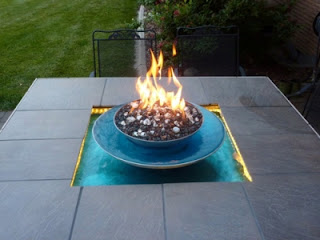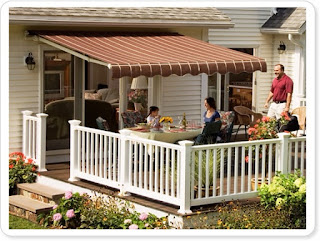Deep shade is always a challenge for finding and maintaining plants that will survive in low light.
Plants need light to photosynthesize so they can't do very dark places at all but can pick up
enough filtered or reflected light even in deep shade if they are adapted to that type of environment.
Even some plants that started out in sunny locations and then are shaded over time by buildings or
trees may survive. I see quite a few gardens like this, where the light changes over the years but some of the original shrubs remain.
There are a couple of factors, besides light, that can affect the plants- struggling to get water and nutrients where tree roots dominate the soil areas, dry shade where eaves of overhanging buildings
block rain, falling leaves burying the plants, and some times toxic excretions from trees like Privets, Eucalyptus or Walnut that keep plants from growing around them.
Extra fertilizing and root pruning of the trees can help, Thinning the canopies of the trees (but not topping or severely cutting them), installing irrigation to supplement rain, and avoiding trees with growth inhibitors or using alternates under them like mulch or pea gravel. Plants in large pots set into the garden work well but should have regular watering- pots dry out easily.
I am including some photos of plants that have been helpful in areas of deep shade. These are picked for the area of my business in Santa Clara and San Mateo County in California so check zones for your area if you live in another county or state.
Names are below the photos.
Aucuba longifoilia 'salicifolia'- willow leaf leaf Aucuba. 3-6' evergreen shrubs
This hybrid isn't very common.
Snails will eat the leaves so use Sluggo, pet safe bait, or a copper tape at base.
Aucuba 'Variegata'- gold dust plant. Not my favorite variegation but can add light to a shaded area.
There are lots of hybrids of varied size, leaf type and variegation. 4-6' high
Aspidistra elatior- cast iron plant. Used a lot indoors or in atriums. Great in pots under trees or inground. Perennial 2' high
Clivia miniata- kaffir lily. The orange is the most available. This plant wants no direct sun.
Perennial 18"-24" high. A great potted plant. Bait for snails with Sluggo.
Orange Clivia
Coleus hybrids. Great in pots or in ground in rich soil for summer and fall color
They are annuals so need to be planted each year in early summer. Lovely though and I miss them when we don't have them. I have had luck taking cuttings and rooting them in glasses of water over the winter. This year I brought a potted one into the kitchen- it will go back on the deck as it
warms up. Heights vary and there are many leaf color options. They do bloom with a stalk with
small blue-purple flowers but it is the foliage that is eye catching.
Begonia- tuberous type. Best in pots for summer color. Save the tubers and they can be replanted the next year or set the pots in a place where they don't get too soggy in winter and they will grow back
as it warms up. Gorgeous colors on these and big leaves so kind of a tropical look. 12-18" high
Pellaea rotundifolia- button fern. Despite their reputation ferns don't always do well in deep shade.
I am showing the easiest and toughest of the bunch. Button fern is 8-12" high
Ferns are perennials.
Nephrolepis cordifolia- Southern Sword Fern. Easy and spreads a bit. Cut off dead fronds at base
to keep them looking good. They can be divided if they get too crowded. 18-24" high
Asparagus Fern- there are several types and are super easy. Be careful, they have interior small thorns. 12-24" high
Campanula murialis- serbian bellflower A great ground cover and the best woodland ground cover that I have found. These are perennial and its good to trim the flowers after bloom.
Camellia japonica. Large shrubs from 3'-15' or more. Absolutely hardy once established. Will bloom better with some light but survive well in deep shade too. Clean up flowers as they drop to avoid petal blight or flowers getting brown spots on. They bloom in early spring or late winter.
Usually red, pink or white colors and there are lots of flower shapes and looks.
A smaller Camellia- this is a Camellia sasanqua and blooms in fall. The plants are
1'-6' depending on hybrid. These are available as espalier too (grown flat on a trellis).
The flower are delicate and smaller than the Camellia japonica.
 |
Fatsia japonica -false aralia. Shown in the sun but grows in deep shade too.
They get about 4-7' tall and are very resilient. |
Osmanthus 'goshiki'- holly leaf Osmanthus. The new growth is pink! I didn't think I would like this plant but have grown to love its unique quality in the garden. It grows very slowly so doesn't overwhelm the borders. It gets 3'-6'. It doesn't seem to bloom but that is not unusual in shaded areas
Osmanthus fragrans. Gorgeous big shrub with fragrant flowers and deep green leaves. They are great screening shrubs and grow 6-10'. They are evergreen shrubs. You may have heard of Osmanthus tea.
Not sure this is the species for tea but its fun to relate the drink to the Genus.
This is also Osmanthus fragrans- just showing the size for you. Again this shows it in sun but
these plants prefer sheltering.
These photos are all of Sarcococca humilis hookeriana. A lovely ground covering
shrub for shaded areas. This is an evergreen shrub 12-24" tall usually. I have seen it taller where it was crowded with other plants or buildings.
Lovely leathery foliage. There is also Sarcococca ruscilfolia which is a 3-4' version of this plant
Their tiny flowers have a great spicy fragrance. Hard to see though.
These are a few good choices that I have tried and tested over the years. Check Sunset Western Garden Book for watering and soil requirements. This is not meant to be a comprehensive list just some helpful suggestions for hard areas to find plants for.
When planting under trees its super important to dig large holes, trimming back tree roots with a sharp tool and filling holes with clean topsoil and compost. Keep up with fertilizing to help the plants compete with the trees.
If using pots- use large ones as they don't dry out as easily and have more room for roots.
Pots 24"-30" high and wide are great. I like Miracle Gro potting soil or moisture retention potting soil. These products have fertilizer for one year built into the mix. Drainage is important so make sure pots have one to 3 holes in the bottom.
Below the eaves along north facing house walls the soil can be terrible. Ammend extensively or replace the soil that comes out of the planting holes with clean topsoil and compost. Make sure the plants get watered in winter as the eaves can keep the areas dry.
Mulch plantings with shredded bark and pull the mulch away from the plant crowns to avoid crown rot. 2" of mulch is good. This will also give the area a more finished look. The mulch breaks down over time and adds to the soil ammendment.
Ask gardeners not to blow off the mulch and not to blow in planted areas more than once or twice a year. Those blowers wreck the low plantings and soil structure. They harm native bees also.
Have fun working in the shade as the weather warms up. Its a great retreat!
one last photo- Brunnera 'jack frost'. 18" tall and can spread by self seeding. These
like moist soil that is rich in organic matter so aren't for every garden but wanted to
include photo as a parting pic.
Labels: plants for shade





























































